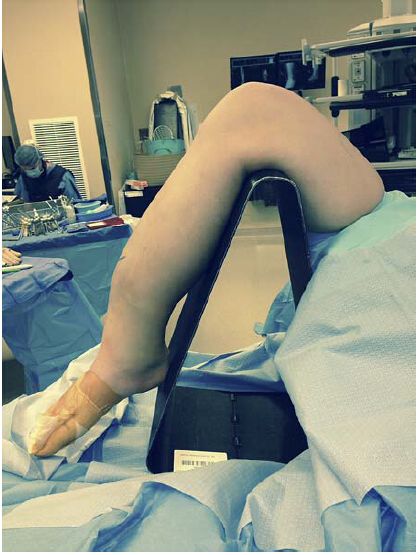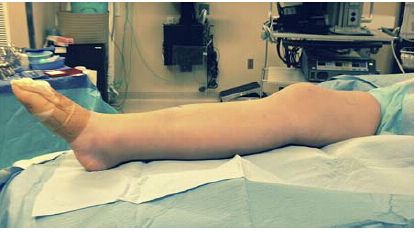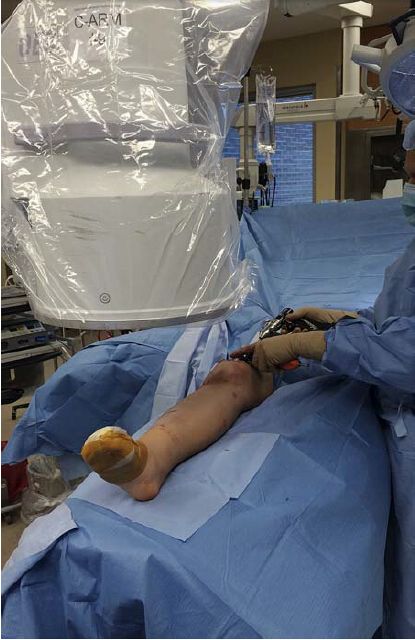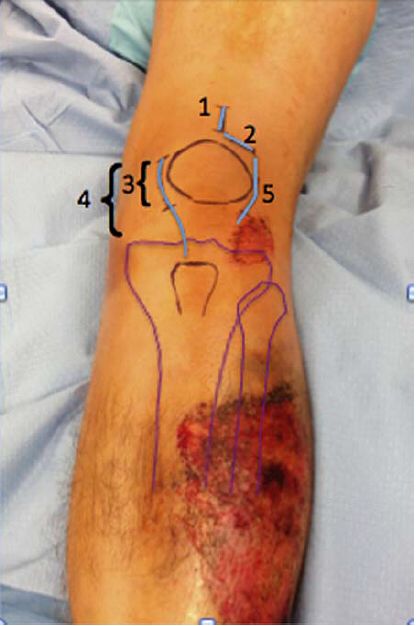The suprapatellar approach is a modified surgical approach for tibial intramedullary nail in the semi-extended knee position. There are many advantages, but also disadvantages, to performing intramedullary nail of the tibia via the suprapatellar approach in the hallux valgus position. Some surgeons are accustomed to using the SPN to treat all tibial fractures except extra-articular fractures of the proximal 1/3 of the tibia.
The indications for SPN are:
1. Comminuted or segmental fractures of the tibial stem. 2;
2. fractures of the distal tibial metaphysis;
3. fracture of the hip or knee with pre-existing limitation of flexion (e.g., degenerative hip joint or fusion, osteoarthritis of the knee) or inability to flex the knee or hip (e.g., posterior dislocation of the hip, fracture of the ipsilateral femur);
4. tibial fracture combined with skin injury at the infrapatellar tendon;
5. a tibial fracture in a patient with an overly long tibia (the proximal end of the tibia is often difficult to visualize under fluoroscopy when the length of the tibia exceeds the length of the tripod through which fluoroscopy can pass).
The advantage of the semi-extended knee position tibial intramedullary nail technique for the treatment of mid-tibial diaphysis and distal tibial fractures lies in the simplicity of repositioning and ease of fluoroscopy. This approach allows for excellent support of the full length of the tibia and easy sagittal reduction of the fracture without the need for manipulation (Figures 1, 2). This eliminates the need for a trained assistant to assist with the intramedullary nail technique.
Figure 1: Typical position for the intramedullary nail technique for the infrapatellar approach: the knee is in a flexed position on a fluoroscopically penetrable tripod. However, this position can exacerbate poor alignment of the fracture block and requires additional reduction techniques for fracture reduction.
Figure 2: In contrast, the extended knee position on the foam ramp facilitates fracture block alignment and subsequent manipulation.
Surgical Techniques
Table / Position The patient lies in the supine position on a fluoroscopic bed. Lower extremity traction may be performed, but is not necessary.The Vascular table is well suited for suprapatellar approach tibial intramedullary nail, but is not necessary. However, most fracture setting beds or fluoroscopic beds are not recommended as they are not suitable for suprapatellar approach tibial intramedullary nail.
Padding the ipsilateral thigh helps to keep the lower extremity in an externally rotated position. A sterile foam ramp is then used to elevate the affected limb above the contralateral side for posterolateral fluoroscopy, and a flexed hip and knee position also aids in guiding the pin and intramedullary nail placement. The optimal knee flexion angle is still debated, with Beltran et al. suggesting a 10° knee flexion and Kubiak suggesting a 30° knee flexion. Most scholars agree that knee flexion angles within these ranges are acceptable.
However, Eastman et al. found that as the knee flexion angle was gradually increased from 10° to 50°, the effect of the femoral talon on percutaneous penetration of the instrument was reduced. Therefore, a greater knee flexion angle will help in selecting the correct intramedullary nail entry position and correcting angular deformities in the sagittal plane.
Fluoroscopy
The C-arm machine should be placed on the opposite side of the table from the affected limb, and if the surgeon is standing on the side of the affected knee, the monitor should be at the head of the C-arm machine and close by. This allows the surgeon and radiologist to easily observe the monitor, except when a distal interlocking nail is to be inserted. Although not mandatory, the authors recommend that the C-arm be moved to the same side and the surgeon to the opposite side when a medial interlocking screw is to be driven. Alternatively, the C-arm machine should be placed on the affected side while the surgeon performs the procedure on the contralateral side (Figure 3). This is the method most commonly used by the authors because it avoids the need for the surgeon to shift from the medial side to the lateral side when driving the distal locking nail.
Figure 3: The surgeon stands on the opposite side of the affected tibia so that the medial interlocking screw can be easily driven. The display is located opposite the surgeon, at the head of the C-arm.
All anteroposterior and medial-lateral fluoroscopic views are obtained without moving the affected limb. This avoids displacement of the fracture site that has been reset before the fracture is completely fixed. In addition, images of the full length of the tibia can be obtained without tilting the C-arm by the method described above.
Skin incision Both limited and properly extended incisions are suitable. The percutaneous suprapatellar approach for intramedullary nail is based on the use of a 3-cm incision to drive the nail. Most of these surgical incisions are longitudinal, but they can also be transverse, as recommended by Dr. Morandi, and the extended incision used by Dr. Tornetta and others is indicated in patients with combined patellar subluxation, who have a predominantly medial or lateral parapatellar approach. Figure 4 shows the different incisions.
Figure 4: Illustration of different surgical incision approaches.1- Suprapatellar transpatellar ligament approach; 2- Parapatellar ligament approach; 3- Medial limited incision parapatellar ligament approach; 4- Medial prolonged incision parapatellar ligament approach; 5- Lateral parapatellar ligament approach. The deep exposure of the parapatellar ligament approach can be either through the joint or outside the joint bursa.
Deep exposure
The percutaneous suprapatellar approach is performed primarily by longitudinally separating the quadriceps tendon until the gap can accommodate the passage of instruments such as intramedullary nails. The parapatellar ligament approach, which passes next to the quadriceps muscle, may also be indicated for the tibial intramedullary nail technique. A blunt trocar needle and cannula are carefully passed through the patellofemoral joint, a procedure that primarily guides the anterior-superior entry point of the tibial intramedullary nail by means of the femoral trocar. Once the trocar is correctly positioned, it must be secured in place to avoid damage to the articular cartilage of the knee.
A large transligamentous incision approach can be used in conjunction with a hyperextension parapatellar skin incision, with either a medial or lateral approach. Although some surgeons do not preserve the bursa intact intraoperatively, Kubiak et al. believe that the bursa should be preserved intact and extra-articular structures should be adequately exposed. Theoretically, this provides excellent protection of the knee joint and prevents damage such as knee infection.
The approach described above also includes a hemi-dislocation of the patella, which reduces the contact pressure on the articular surfaces to some extent. When it is difficult to perform patellofemoral joint assessment with a small joint cavity and a significantly limited knee extension device, the authors recommend that the patella can be semi-dislocated by ligament separation. The median transverse incision, on the other hand, avoids damage to the supporting ligaments, but it is difficult to perform a successful knee injury repair.
The SPN needle entry point is the same as that of the infrapatellar approach. Anterior and lateral fluoroscopy during needle insertion ensures that the needle insertion point is correct. The surgeon must ensure that the guiding needle is not driven too far posteriorly into the proximal tibia. If it is driven too deeply posteriorly, it should be repositioned with the help of a blocking nail under posterior coronal fluoroscopy. In addition, Eastman et al. believe that drilling the entry pin in a pronounced flexed knee position aids in subsequent fracture repositioning in the hyperextended position.
Reduction tools
Practical tools for reduction include point reduction forceps of different sizes, femoral lifters, external fixation devices, and internal fixators for fixation of small fracture fragments with a single cortical plate. Blocking nails can also be used for the above mentioned reduction process. Reduction hammers are used to correct sagittal angulation and transverse displacement deformities.
Implants
Many manufacturers of orthopedic internal fixators have developed instrumented use systems to guide the standard placement of tibial intramedullary nails. It includes an extended positioning arm, a guided pin length measurement device, and a medullary expander. It is very important that the trocar and blunt trocar pins protect the intramedullary nail access well. The surgeon must reconfirm the position of the cannula so that injury to the patellofemoral joint or periarticular structures due to too close proximity to the driving device does not occur.
Locking Screws
The surgeon must ensure that a sufficient number of locking screws are inserted to maintain satisfactory reduction. Fixation of small fracture fragments (proximal or distal) is accomplished with 3 or more locking screws between adjacent fracture fragments, or with fixed-angle screws alone. The suprapatellar approach to the tibial intramedullary nail technique is similar to the infrapatellar approach in terms of screw driving technique. Locking screws are more accurately driven under fluoroscopy.
Wound closure
Suction with a suitable outer casing during dilatation removes free bone fragments. All wounds need to be thoroughly irrigated, especially the knee surgical site. The quadriceps tendon or ligament layer and the suture at the site of the rupture are then closed, followed by closure of the dermis and skin.
Removal of the intramedullary nail
Whether a tibial intramedullary nail driven through a suprapatellar approach can be removed through a different surgical approach remains controversial. The most common approach is the transarticular suprapatellar approach for intramedullary nail removal. This technique exposes the nail by drilling through the suprapatellar intramedullary nail channel using a 5.5 mm hollow drill. The nail removal tool is then driven through the channel, but this maneuver can be difficult. The parapatellar and infrapatellar approaches are alternative methods of removing intramedullary nails.
Risks The surgical risks of the suprapatellar approach to the tibial intramedullary nail technique are medical injury to the patella and femoral talus cartilage, medical injury to other intra-articular structures, joint infection, and intra-articular debris. However, there is a lack of corresponding clinical case reports. Patients with chondromalacia will be more prone to medically induced cartilage injuries. Medical damage to patellar and femoral articular surface structures is a major concern for surgeons using this surgical approach, especially the transarticular approach.
To date, there is no statistical clinical evidence on the advantages and disadvantages of the semi-extension tibial intramedullary nail technique.
Post time: Oct-23-2023














